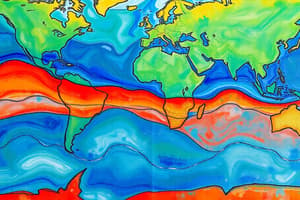Podcast
Questions and Answers
What is the definition of oceanic crust?
What is the definition of oceanic crust?
- The landmass of continents
- Thinner than the continental crust and made of granite
- Below the oceans, thinner than continental crust, made of basalt, and denser (correct)
- A type of rock found in mountains
What is the thickness of oceanic crust?
What is the thickness of oceanic crust?
5-10 km
What is the thickness of continental crust?
What is the thickness of continental crust?
30-50 km
Which rock type is found in oceanic crust?
Which rock type is found in oceanic crust?
Which rock type is generally found in continental crust?
Which rock type is generally found in continental crust?
Oceanic crust is older than continental crust.
Oceanic crust is older than continental crust.
Continental crust is less dense than oceanic crust.
Continental crust is less dense than oceanic crust.
What is the age of oceanic crust?
What is the age of oceanic crust?
What is the age of continental crust?
What is the age of continental crust?
Which type of crust is more dense?
Which type of crust is more dense?
Which crust has greater buoyancy?
Which crust has greater buoyancy?
Flashcards are hidden until you start studying
Study Notes
Oceanic Crust
- Comprises the part of Earth's crust located beneath oceans.
- Thinner than continental crust, typically ranging from 5 to 10 km in thickness.
- Mainly composed of basalt, a dark, dense igneous rock with a fine texture.
- More dense than continental crust, contributing to its tendency to sit lower in the mantle.
- Age of oceanic crust is relatively younger compared to continental crust.
Continental Crust
- Located underneath the continents, it is significantly thicker, varying between 30 to 50 km.
- Primarily composed of granite, which is lighter in color and less dense than basalt.
- Older than oceanic crust, containing much of Earth's geological history.
- Less dense than oceanic crust, which allows it to float higher on the mantle.
Key Differences
- Composition: Oceanic crust is made of basalt; continental crust is made of granite.
- Thickness: Oceanic crust is thinner (5-10 km) versus thicker continental crust (30-50 km).
- Density: Oceanic crust is denser than continental crust, affecting their buoyancy.
- Age: Oceanic crust is generally younger while continental crust is older.
Buoyancy
- Refers to the capacity of an object to float in a fluid, influenced by the density of the object compared to the fluid.
Studying That Suits You
Use AI to generate personalized quizzes and flashcards to suit your learning preferences.



